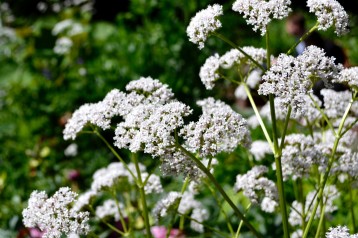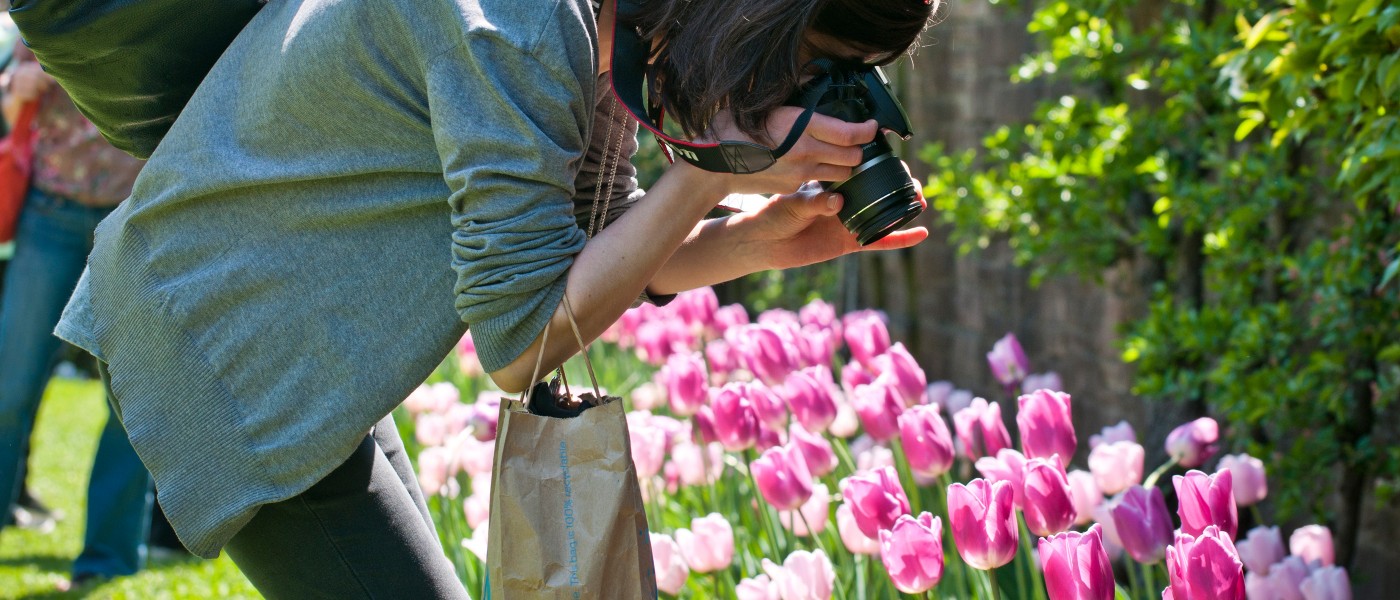Plants in Bloom
June highlights

Queen-of-the-Prairie
The spectacular fuzzy pink flowers of this native prairie plant rise above surrounding plants. They have a light, lilac-like fragrance.
Filipendula rubra (queen-of-the-prairie) in the Discovery Garden. Photo: Blanca Begert.

Hardy Water-Lily ‘Colorado’
The striking blooms of water-lilies (Nymphaea spp.) famously inspired hundreds of paintings by Claude Monet. This hardy cultivar boasts peach-hued flowers and a long bloom time.
Nymphaea ‘Colorado’ (hardy water-lily) on Lily Pool Terrace. Photo: Michael Stewart.

Butterfly Weed
Butterfly weed attracts monarchs and other butterflies. Adults feed on nectar from the blossoms, while caterpillars munch on the leaves.
Asclepias tuberosa (butterfly weed) in the Native Flora Garden. Photo: Blanca Begert.

Black-Eyed Susan
This native wildflower blooms from summer into early fall and attracts butterflies and bees of all kinds.
Rudbeckia hirta (black-eyed Susan) on the Overlook. Photo: Michael Stewart.

Valerian
A tall clumping perennial native to Europe and Asia, valerian has been grown as a medicinal herb since at least the time of Hippocrates. Valerian is considered invasive or noxious in some areas, including parts of New England and the Great Lakes region.
Valerian officinalis (valerian) in the Herb Garden. Photo: Blanca Begert.

Dyers’ Tickseed
This annual boasts bright yellow and maroon flowers that bloom alongside wispy, lacelike foliage. A member of the Asteraceae, or daisy family, dyers’ tickseed attracts insect pollinators as well as granivorous birds.
Coreopsis tinctoria (dyers’ tickseed) in the Water Garden. Photo: Michael Stewart.

Prickly-Pear
The prickly-pear is known for its defensive spines and eye-catching flowers—as well as its tasty fruit and pads, or nopales, which have a long legacy of culinary use in Mexico and the Southwest.
Optuntia species (prickly-pear) in the Rock Garden, Overlook, and Native Flora Garden. Photo: Steven N. Severinghaus.

Pale Purple Coneflower
A member of the Asteraceae, or aster family, this native herbaceous perennial attracts butterflies and bees. Its genus name comes from “echinos,” the Greek word for hedgehog, in reference to its prickly seed head.
Echinacea pallida (pale purple coneflower) in the Water Garden, Visitor Center, and Discovery Garden. Photo: Michael Stewart.

Mountain Laurel
This native shrub produces exquisite clusters of delicate fused-petal blossoms.
Kalmia latifolia (mountain laurel) in the Discovery Garden. Photo: Lee Patrick.

Floribunda Rose
Large, lush cup-shaped flowers adorn this floribunda shrub rose, which blooms repeatedly from early summer through fall.
Rosa POSEIDON = ‘Korfriedhar’ (floribunda rose) in the Rose Garden. Photo: Michael Stewart.

Hybrid Wichurana Rose
Introduced in 1899, this large-flowered, creamy-yellow rambling rose was named after its very sweet fragrance.
Rosa ‘Gardenia’ (hybrid wichurana rose) in the Rose Garden. Photo: Michael Stewart.

Hybrid Tea Rose Frederic Mistral
A classic hybrid tea rose with a large, single bloom at the end of a long stem and a sweet fragrance, this pink cultivar was named after the Nobel Prize-winning French poet.
Rosa Frederic Mistral = ‘Meitebros’ (hybrid tea rose Frederic Mistral) in the Rose Garden. Photo: Jean-Marc Grambert.

White Evening Primrose
You can find this evening primrose cultivar, with its gently nodding cup-shaped blossoms, in the Rock Garden near the edge of the pond. Oenothera speciosa is native to the grasslands of the midwest and southwest United States.
Oenothera speciosa ‘Rosea’ (white evening primrose) in the Rock Garden. Photo: Blanca Begert.

Tulip Tree
Flowers high up in this tall native tree resemble tulips. In Ohkehteau (Plants of the Earth): A Shinnecock Oral History, Shinnecock Indian Nation tribal member Chenae Bullock shares that the tulip tree, with its massive height, is a popular canoe-making tree.
Liriodendron tulipifera (tulip tree) in the Woodland Garden. Photo: Blanca Begert.

Hybrid Rugosa Rose
This hardy hybrid, which blooms repeatedly throughout the season, has several layers of ruffled pink petals, striking red canes, and a memorable clove-like fragrance.
Rosa ‘Thérèse Bugnet’ (hybrid rugosa rose) in the Rose Garden. Photo: Jean-Marc Grambert.

Fragrant Water-Lily
Native to the eastern United States, Nymphaea odorata produces glowing white blooms and are often fragrant (hence the name). This floating wetland plant offers food and habitat to a wide variety of insects, reptiles, and mammals.
Nymphaea odorata (fragrant water-lily) in the Native Flora Garden. Photo: Michael Stewart.

Hybrid Tea Rose
The original Peace rose was cultivated in France before World War II and was given its name in 1945 to signify hope for lasting peace. ‘Flaming Peace’ was bred in 1966 and is one of several Peace hybrids developed from the original.
Rosa ‘Flaming Peace’ (hybrid tea rose) in the Rose Garden. Photo: Rebecca Bullene.

Catmint ‘Six Hills Giant’
Species in the Nepeta genus are native to Europe, Asia, and Africa. Though not as compelling to cats as true catnip, this aromatic perennial species is still a feline magnet.
Nepeta ‘Six Hills Giant’ (catmint) in the Fragrance Garden and Perennial Border. Photo: Alvina Lai.

Large-Flowered Climber Rose
This hybrid wichurana rose boasts pale apricot-colored flowers blooming on canes that can measure 10 to 20 feet in length. You can find this climbing rose scrambling up the pavilion of the Rose Garden, framing one of the viewing windows.
Rosa ‘Auguste Gervais’ (large-flowered climber rose) in the Rose Garden. Photo: Michael Stewart.

Scotch Thistle
This spiny biennial, native to Europe and western Asia, can grow above six feet tall.
Onopordum acanthium (Scotch thistle) in the Shakespeare Garden. Photo: Michael Stewart.

Clematis ‘Rooguchi’
Clematis species are excellent climbers, and popular perennial garden vines. This hybrid cultivar, developed in Japan by plant breeder Kazushige Ozawa, has bell-shaped purple flowers that bloom throughout the summer.
Clematis ‘Rooguchi’ (integrifolia clematis) in the Rose Garden. Photo: Michael Stewart.

Blue False Indigo
Native to eastern North America, this long-lived perennial attracts butterflies like the eastern-tailed blue (Cupido comyntas). Like other members of the pea family, Baptisia australis works with bacteria to pull nitrogen from the air and "fix" or transform it into usable form.
Baptisia australis (blue false indigo) in the Discovery Garden. Photo: Blanca Begert.

Wild Strawberry
This ground-hugging native plant produces five-petaled white flowers and a sweet edible fruit.
Fragaria virginiana (wild strawberry) on the Overlook. Photo: Michael Stewart.

Avens ‘Totally Tangerine’
This sun-loving cultivar is related to strawberries, and produces a crush of peachy-hued blooms in late spring through summer.
Geum ‘Totally Tangerine’ (PBR) (avens ‘Totally Tangerine’) in the Plant Family Collection. Photo: Michael Stewart.

Southern Catalpa
The flowers of this native tree look pure white from a distance, but up close, the purple and gold nectar guides can be seen. These markings help draw in bees during the day. At night, months are attracted to the white color and strong fragrance.
Catalpa bignonioides (southern catalpa) in the Plant Family Collection. Photo: Steven N. Severinghaus.

Shrub Rose
This apricot-colored rose blooms in early summer and again later, usually along with the second flush of blooms in September.
Rosa ‘Cubana’ (shrub rose) in the Rose Garden. Photo: Michael Stewart.

Japanese Hydrangea Vine ‘Moonlight’
This climbing vine has heart-shaped leaves and white flowers that bloom in early summer.
Hydrangea hydrangeoides f. concolor ‘Moonlight’ (Japanese hydrangea vine) in the Woodland Shade Garden. Photo: Michael Stewart.

Milky Bellflower
Native to western Asia, this summer-blooming herbaceous perennial produces soft clusters of bell-shaped flowers. The specific epithet lactiflora is Latin for “milk-white flowers.”
Campanula lactiflora (milky bellflower) in the Water Garden. Photo: Michael Stewart.

Common Foxglove
Native to western Europe, common foxglove is a perennial in the plantain family. Its striking tubular blooms are a popular cottage garden feature.
Digitalis purpurea ‘Foxy’ (common foxglove) in the Shakespeare Garden. Photo: Alvina Lai.

Pseudata Iris
Iris ‘Kuragawa Noh’ (pseudata iris) in the Japanese Hill-and-Pond Garden. Photo: Steven N. Severinghaus.

Shrub Rose
This lovely shrub rose hybrid blooms repeatedly starting in late spring through fall.
Rosa ‘Surf Rider’ (shrub rose) in the Rose Garden. Photo: Michael Stewart.

Dogwood ‘Elizabeth Lustgarten’
Pointed white bracts adorn cascading branches on this long-blooming dogwood. Its flowers mature into berries in fall.
Cornus kousa ‘Elizabeth Lustgarten’ (dogwood ‘Elizabeth Lustgarten’) in the Children’s Garden. Photo: Michael Stewart.

Dogwood [Venus]
This hybrid, which offers large blooms of white, iridescent bracts, was introduced by Rutgers University’s dogwood breeding program.
Cornus × elwinortonii VENUS = ‘Kn30 8’ (PBR) (Jersey Star Series) (dogwood [venus]) in the Osborne Garden. Photo: Michael Stewart.

Black Stem Bigleaf Hydrangea
The large, showy summer flowers of hydrangeas make them a popular garden plant. The bloom color of some species is influenced by soil pH. More acidic soil will produce bluer flowers, while more alkaline soil will produce pinker ones.
Hydrangea macrophylla ‘Nigra’ (black stem bigleaf hydrangea) in the Plant Family Collection. Photo: Blanca Begert.

Sweetbay
This native magnolia species has creamy white flowers that bloom in late spring, sometimes into summer, with a sweet lemony scent.
Magnolia virginiana (sweetbay) in the Native Flora Garden. Photo: Steven N. Severinghaus.

Ghent Azalea
One of a group of deciduous azaleas bred in Ghent, Belgium in the early 1800s, the ‘Raphael de Smet’ hybrid has lovely pink flowers that bloom in late spring.
Rhododendron ‘Raphael de Smet’ (Ghent azalea) in the Woodland Garden. Photo: Steven N. Severinghaus.

Bottlebrush Buckeye
The fluffy white flower clusters of this native shrub appear in summer and really do resemble their namesake.
Aesculus parviflora (bottlebrush buckeye) in the Plant Family Collection. Photo: Blanca Begert.

Hybrid Spinosissima Rose
This hybrid rose, as the name suggests, is spiny—or, technically, prickly. (True spines come from leaf tissue, prickles from dermal tissue.)
Rosa ‘Frühlingsschnee’ (hybrid Spinosissima rose) in the Rose Garden. Photo: Sarah Schmidt.

Plantain-Lily
Commonly known as hostas, plantain-lilies are shade-loving perennials. This cultivar generates bell-shaped lavender blooms in early summer.
Hosta ‘Blue Wedgewood’ (plantain-lily) in the Fragrance Garden. Photo: Blanca Begert.

Pinkflower Hedgehog Cactus
As the name suggests, this small succulent produces vibrant blooms, followed by an edible red fruit.
Echinocereus fendleri subsp. fendleri (hedgehog cactus) in the Rock Garden. Photo: Blanca Begert.

Flame Azalea
Bumble bees are attracted to the flame azalea’s funnel-shaped flowers, which bloom in a mix of yellow, orange, and red. This deciduous shrub is a member of the Ericaceae, or heath family, and is native to eastern North America.
Rhododendron calendulaceum (flame azalea) in the Native Flora Garden. Photo: Michael Stewart.

